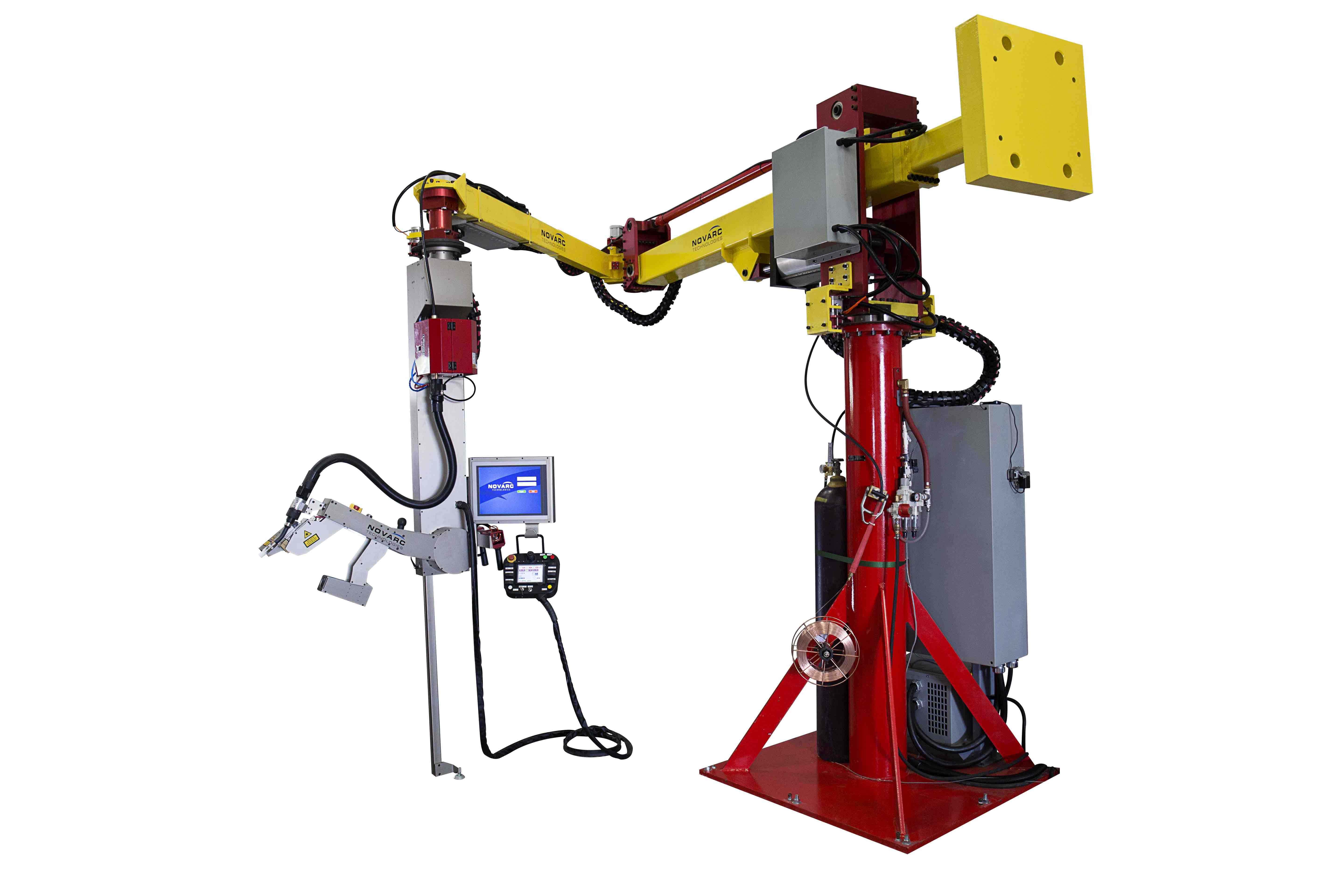When you see a solution like the collaborative Spool Welding Robot, there are sure to be questions. Some simple, some more complex. Based on your feedback, we've compiled the 23 most frequently asked questions on the collaborative Spool Welding Robot to answer for you.
1. What are the main features of the collaborative Spool Welding Robot?
Safety
As a collaborative welding robot, the SWR meets all the safety requirements of ISO15066; therefore it does not require any fencing or safety curtains.
Reach
Among industrial spool welding robots, the SWR has the largest ratio of reach to footprint. For example, if a shop’s footprint is 24 SF, the SWR has a radial reach of 15” which allows for welds in pipe modules and spools up to and including 30”.
Ergonomics
Designed for semi-automatic 1G roll welding, the SWR significantly improves the ergonomics of pipe welding by having the robot take on the weave motion.
Data Logging and Reporting
The SWR provides repeatability and reliability; The NovData™ logging software captures all available data for each weld pass for future analysis and reporting.
Weld Monitoring
The SWR provides a monitoring system (NovEye™) that records each weld for analysis and future production improvements.
Laser-Based Distance Control and Seam Tracking
Using a laser camera and closed-loop control systems, the SWR automatically maintains the torch to pipe distance with 0.1mm accuracy and assists the operator in seam tracking so primary focus can remain on the weld.
2. What are Collaborative Robots?
Collaborative robots (cobots) are a new family of robots which are safe to collaborate with people on a factory floor. In contrast with robots, cobots do not require a safety cell; instead they work with human operators.
Cobots don’t require to be programmed and they are very easy to work with. In addition, they are less expensive and have small footprints compared to traditional robots.
There are many generic six-axis cobots on the market today including Universal Robots, Rethink Robots, YuMi and others.

3. What size of pipe can be welded with the SWR?
The base model of the SWR can weld Schedule 40 and Schedule 80 pipes from 4” and up. If your pipe falls outside these specs, we can help you but need to know more about your application first.
4. Which welding processes can the SWR support?
The primary welding process is GMAW, FCAW and MCAW. We use modified short-circuit on root (STT, RMD, LSC) and use modified waveform pulse processes for solid wire flux core or metal-cored wire for fill and cap passes.
TIG, SAW and FCAW are also available as custom options. Talk to our sales team if you’d like to know more about your specific process.
5. What material can be welded with the SWR?
SWR can weld mild steel, stainless steel and special alloys.
6. Can I use my existing positioner?
Yes. Most any standard pipe positioner works with the Spool Welding Robot to produce quality welds.
7. Does the SWR fall under robotic welding from a welding procedure standpoint?
Based on industry standards, the SWR falls under mechanized welding, given that the operator interacts with the machine and makes on-the-fly adjustments. This means - among other things - that fencing or a protective barrier is not required for the SWR to operate.
/Novarc%20Technologies/Artwork%20for%20Landing%20Page/Spool-welding-robot-small-footrpint-01.png?width=300&name=Spool-welding-robot-small-footrpint-01.png)
8. What is the floor layout required for the SWR?
The SWR takes a 4’ x 6’ floor footprint, and it does not block forklift traffic nor interfere with shop cranes, as the arm arm and boom can be extended and retracted to accommodate activity on the production floor.
9. How much productivity and capacity can I expect from using the SWR?
A significant amount of productivity and capacity can be expected from using the SWR, but how much exactly depends on your current welding process. As a general rule of thumb from extensive research and user experience, one SWR with an operator can produce the same output as 4 welders using SMAW, and 2 welders using manual GMAW.
By eliminating the torch hand control, the mechanized weave relieves welder fatigue. This allows the Spool Welding Robot to produce a higher deposition rate, higher production, faster track speeds and the ability to run pre-programmed welds.
11. What is the ROI to invest in an SWR unit?
With just a few details about your operation, we’ll have your ROI calculated: http://novarctech.com/roi
12. How does the SWR fit into a production flow?
The SWR is designed to fit in pipe fabrication shops because the height does not interfere with overhead cranes. In addition, the SWR can be easily parked away to allow shop traffic to pass.
13. How long does it take to install and commission the SWR?
It takes two days to install the SWR and only one day to commission it.
14. How long does it take to train an operator and what skill level should they have?
It takes 2-3 days to train an operator for both operations and maintenance.
The operators should know the basics of welding and have some welding experience.
15. How can I monitor the production of the SWR?
The SWR comes with the NovData™ production monitoring software that produces daily reports. The daily report includes the following information:
- Production time
- Welding time
- Pipe diameter
It also creates a time-stamped log file with:
- Voltage
- Weld Current
- Wire Feed Speed
- Travel speed
- Other relevant weld and motion parameters for each weld
The SWR also comes with a camera built into its robotic arm. With this feature, operators get a clear view from inside the groove on the HMI as each weld progresses in real time. NovEye records all videos for future analysis.
16. What shielding gas is required?
Welding shielding depends on the weld process and filler metal. Our technical team can assist you with specific welding applications. The SWR uses 15% CO2 and 85% Argon for root to cap welding on steel pipe.
17. What type of joint preparation and tolerance are required?
The STT is highly tolerant of pipe prep variations. Typically the SWR requires less than 3mm hi-lo in pipes.
18. What are the power and air requirements?
The SWR needs 3 phase power and minimum 85 PSI compressed air. The electrical power can be any of the standard voltages between 208V and 600V.
The SWR has built-in speed and torque monitoring systems that ensure speed and forces are within required levels at all times.
20. How much maintenance is required on the SWR?
The SWR is designed to be a robust machine. As a result, only minimal maintenance is required. Maintenance training is included with the robot training.
21. Can the SWR be moved around the shop?
The SWR needs to be anchored to a minimum 6” concrete slab . However, you can move it between previously installed base locations using overhead cranes.
22. Can the SWR be used outside the pipe shop?
The SWR is designed for indoor usage. It can be used in the field or in a work yard, provided it is protected from the elements.
23. How heavy is the SWR?
The SWR weighs approximately 3000 lbs.
Interested? Book a live SWR demonstration – on site or as an online demo!


